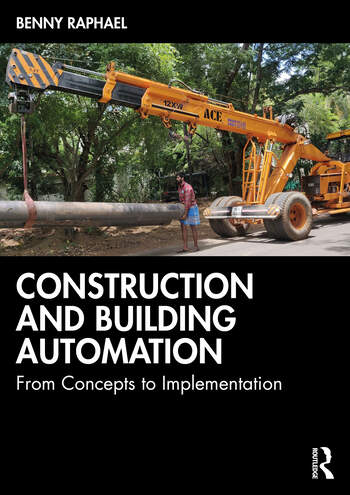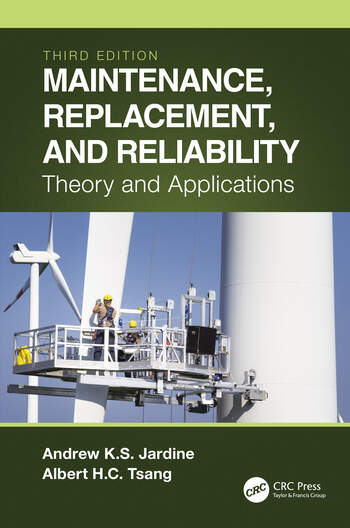As a departure from the usual fare, this edition reviews textbooks intended for architecture, engineering, and project management students. That doesn’t mean these books have no application to facilities professionals—they do, in myriad ways that I hope are evident.
CONSTRUCTION AND BUILDING AUTOMATION: FROM CONCEPTS TO IMPLEMENTATION
Benny Raphael, Routledge, New York, NY, 2023, 276 pp., softcover ($56.95), hardcover ($160), ebook ($51.25).
The Internet of Things (IoT) is discussed in the media on a regular basis. Some people understand it, and some don’t. Planning to use IoT well is important for facility officers and easier to implement if thought about in advance.
 As a textbook, Construction and Building Automation includes exercises and problems meant to challenge the reader. But the book’s most important feature is its presentation of the physical and engineering basics about lighting, cooling, heating; other typical elements of building automation; and opportunities for management to provide more effective occupant support and energy conservation. Many of the reasons to utilize building automation and ways to implement it successfully are known by most APPA members. However, the descriptions of “what” and “why” are very helpful and can stimulate thinking about other applications.
As a textbook, Construction and Building Automation includes exercises and problems meant to challenge the reader. But the book’s most important feature is its presentation of the physical and engineering basics about lighting, cooling, heating; other typical elements of building automation; and opportunities for management to provide more effective occupant support and energy conservation. Many of the reasons to utilize building automation and ways to implement it successfully are known by most APPA members. However, the descriptions of “what” and “why” are very helpful and can stimulate thinking about other applications.
While automation for operations is familiar and implemented easily in new construction, automation of the construction process is more difficult. Essentially, methods of construction have not changed for decades, if not centuries or millennia. There is still a great deal of construction that occurs “stick built,” piece by piece on the site. There have been some efforts to modularize construction to allow for large assemblies to be installed all at once with a crane lift. These projects require involvement with the owner and designer early in the process before the builder can make significant progress. However, there are limited opportunities to automate the construction process.
Automation—or a different way of doing construction—is still needed. While Construction and Building Automation does not create or identify solutions, it clearly explains the process, including the physical, mechanical, logistic, and software requirements necessary for creative engineers to develop systems and equipment. Heavy reliance on a shrinking labor pool for construction going forward should compel faster development and adoption. This publication will help inspire the thinking of those looking for new methods.
MAINTENANCE, REPLACEMENT, AND RELIABILITY: THEORY AND APPLICATIONS
Andrew K. S. Jardine and Albert H.C. Tsang, Routledge, NY, 2022, 3rd ed., 412 pp., hardcover ($130), ebook ($117).
There is no shortage of facility management books, and there certainly are a reasonable number of business-focused people involved in facility management. However, there are also many engineers involved in facility management. They make things work, they understand the equipment used in buildings, and they focus on what will make facilities better. But the texts they learn from are focused more on design and less on operations.
 Maintenance, Replacement, and Reliability (3rd ed.) is focused on engineers and many of the mathematical applications that demonstrate good decision making about operating equipment. There are five clearly organized chapters that present a logical process for moving from minor maintenance to capital replacement and developing numerical validation for all.
Maintenance, Replacement, and Reliability (3rd ed.) is focused on engineers and many of the mathematical applications that demonstrate good decision making about operating equipment. There are five clearly organized chapters that present a logical process for moving from minor maintenance to capital replacement and developing numerical validation for all.
Many facility managers know that equipment maintenance focused on prevention, prediction, and reliability is usually the cheapest way to maintain facility equipment. We believe it—but frequently don’t practice it. Why is that? It’s possible that the facility manager is unable to gather the necessary data, analyze it, and then demonstrate the economical decision necessary to convince a financial officer. Maintenance, Replacement, and Reliability provides the tools and processes necessary to use those tools that were learned in a university course but were not tied to practical application in facilities.
This text is not for those who fear mathematics (algebra, calculus, and differential equations). That’s right, it’s serious engineering. As a result, it requires some fundamental understanding of what makes mechanical (and other) systems work efficiently. That’s where it is unique and useful. In addition to addressing when to replace components and equipment to ensure the facility operates well, it treats staffing, right sizing the organization, and the troubling problem of managing workload.
While this is clearly not a book for quick solutions or light reading, it is a serious book that provides for good decisions made with data and analysis. There is a substantial appendix including analytical techniques and tables for relevant mathematical functions. By far, it is the best book found to date that addresses facility maintenance and operations from an engineering perspective.
Ted Weidner is professor of engineering practice at Purdue University, West Lafayette, IN, and consults on facilities management issues primarily for educational organizations. He can be reached at [email protected]. If you would like to write a book review, please contact Ted directly.
Bookshelf
Book reviews on current publications relevant to the profession, trends, and working environment of facilities and educational managers and professionals. To contribute a book review, contact Ted Weidner, field editor of this column.
See all Bookshelves.


